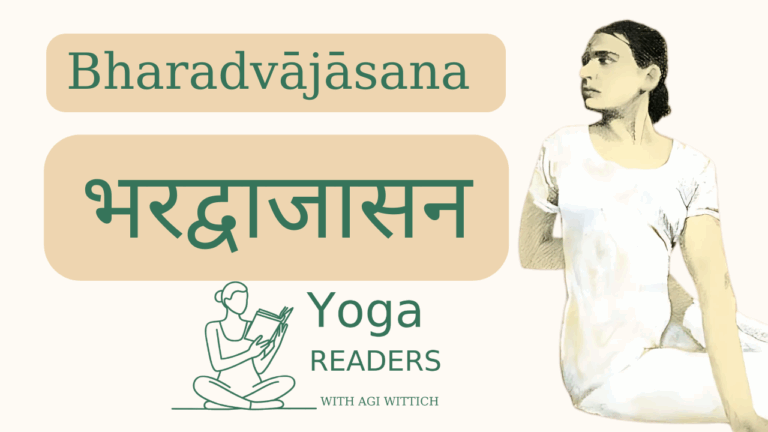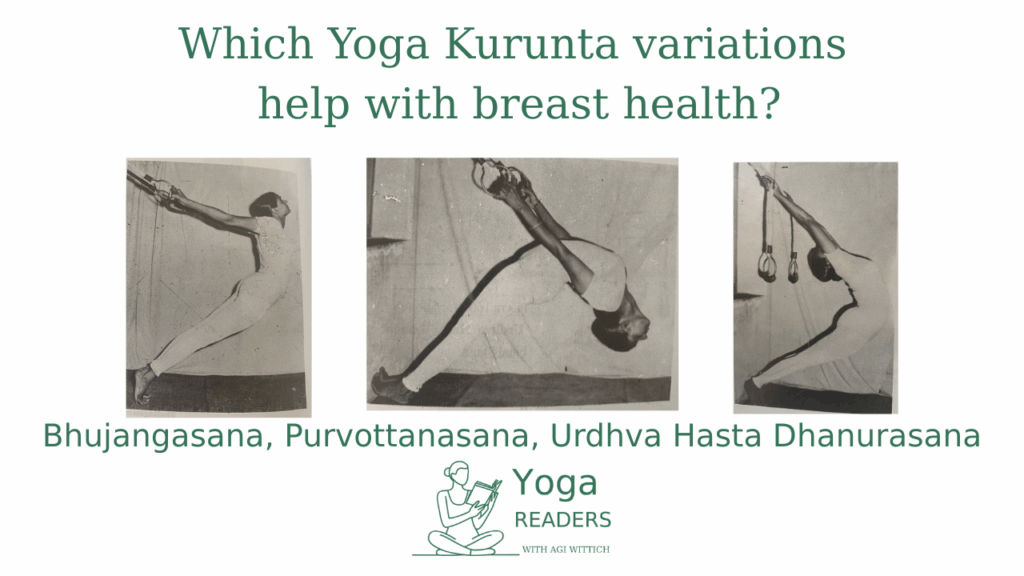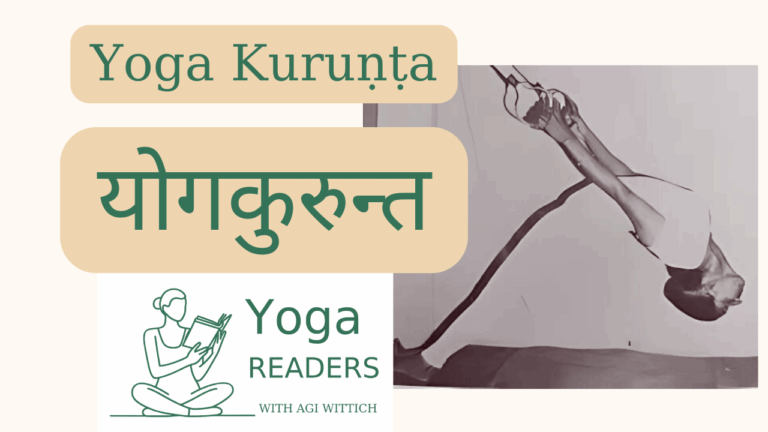
Bharadvājāsana: The Sage’s Twist – Understanding the Posture and its Namesake
In the vast tradition of yoga āsanas, certain poses carry not just
| Reading Unit 6 includes VI Asanas: Twists, VII Asanas: Backbends, VIII Asanas: Yoga Kurunta |
This unit highlights the unique benefits of twisting poses for women, focusing on their role in toning abdominal organs, supporting digestion, menstrual health, and postnatal recovery. It offers a gradual progression from Bharadvajasana I to deeper twists like Pasasana, with clear instructions and therapeutic guidance that balance safe alignment with effective practice.
The backbend section addresses the physical and emotional strain of habitual forward movement, showing how extensions like Ustrasana and Urdhva Dhanurasana restore spinal health, boost circulation, and build inner resilience. With thoughtful sequencing and use of props, Geeta offers safe, empowering ways to approach these challenging poses, especially for women navigating menopause or emotional fatigue.
In the Yoga Kurunta section, rope work is introduced as a method that enhances alignment, body awareness, and accessibility. Geeta uses vivid imagery and precise instructions to show how ropes support practitioners through postpartum recovery and structural challenges, blending traditional rigor with therapeutic sensitivity.
This section highlights the importance of twisting poses, particularly for women, as they help tone, massage, and rejuvenate the abdominal organs. It presents five primary twists with detailed technical instructions, modifications, and therapeutic applications. The progression begins with Bharadvajasana I and advances to more complex twists like Pasasana, ensuring safe development of spinal flexibility. The text emphasizes the therapeutic benefits of twists, particularly for digestive health, menstrual issues, and postnatal recovery. Special attention is given to spinal health, alignment, and breath coordination. The section balances the encouragement of practice with safety precautions, making it a valuable resource for practitioners and teachers.
This section addresses the imbalance caused by modern forward-bending habits and emphasizes backbends’ role in improving circulation, respiration, and spinal health. It progresses from simpler poses like Ustrasana to advanced backbends like Urdhva Dhanurasana, offering detailed modifications and preparatory steps. The therapeutic applications cover physical and psychological benefits, including spinal health, emotional resilience, and menopausal support. The text carefully balances encouragement and safety, ensuring accessibility through props and modifications. The section concludes by emphasizing how backbends build strength, flexibility, and courage while counteracting the physical strains of daily activities, particularly for women.
The section “Yoga Kurunta” explores the use of rope support in yoga, likening the practitioner to both puppeteer and puppet. It highlights the benefits of rope work, especially for women facing post-pregnancy challenges or body weight distribution issues. The text provides detailed instructions for safe setup and pose progression, emphasizing how ropes aid in alignment, body awareness, and accessibility without compromising traditional methodology. Therapeutic applications are also discussed, with modifications for various conditions. The section balances technical precision with a deep understanding of yoga props, making it a valuable resource for practitioners and teachers.
How does Geeta explain the relationship between daily movement patterns and the need for specific poses like backbends?
How does Geeta address the psychological aspects of challenging poses, particularly in building courage and emotional stability?
How does Geeta balance encouraging practice with ensuring safety in these more demanding poses?
In our sixth unit exploring Geeta Iyengar’s foundational text Yoga: A Gem for Women, we engaged in a deep and expansive study of three potent categories of asanas: twisting postures, backward extensions (backbends), and the supported practice of Yoga Kurunta (wall rope work). This session illuminated how these families of postures are not merely technical exercises, but vital tools for supporting the physical, emotional, and spiritual health of women.
Geeta presents twisting postures as daily essentials rather than occasional additions. These lateral movements of the spine, including seated asanas such as Bharadvajasana and Marichyasana III, offer profound therapeutic value. Through rhythmic compression and release of the abdominal organs, they promote digestive health and internal balance. Beyond that, twists support hormonal regulation and menstrual health, increase spinal mobility, and address specific conditions such as indigestion, diabetes, and liver or kidney issues. Particularly for women in periods of transition—like menopause or postpartum recovery—these postures play a crucial role in restoring equilibrium.
Throughout the session, we saw how Geeta’s teaching approach is rooted in compassion and precision. For practitioners who cannot perform the full classical postures independently, she offers wall-supported adaptations that maintain both the action and the benefit. This ensures that the transformative potential of twisting remains accessible, regardless of experience level or physical limitations.
Turning to backward extensions, we explored how Geeta frames these asanas not only as physical openers, but as builders of courage and resilience. In contrast to the habitual anterior collapse that comes with daily life—especially in caregiving roles or during emotional fatigue—backbends bring lift, expansion, and clarity. Their effects span the physiological and the psychological: improving circulation, respiratory capacity, and spinal strength, while also counteracting depression, lethargy, and fear. Practiced with intelligence and support, these postures stimulate the nervous system and simultaneously offer profound relaxation. The session highlighted specific backbend adaptations using props such as chairs and bolsters, particularly beneficial for elderly practitioners and for women navigating hormonal shifts. Geeta’s focus on breast health in this context further underscored the integrative nature of her therapeutic vision.
The section on Yoga Kurunta revealed the art and science behind working with wall ropes. Geeta reimagines traditional asanas through the support of ropes, allowing the practitioner to become both the puppeteer and the puppet—a metaphor that captures the sense of both agency and surrender embedded in this work. Rope wall practice enhances safety, reduces risk of injury, and opens access to advanced poses for practitioners of varying abilities. It is particularly useful for addressing spinal conditions, shoulder tension, and postnatal recovery. By providing direction, traction, and support, the ropes help develop strength, confidence, and alignment awareness that carry over into independent practice.
A key thread running through the entire session was Geeta’s attention to detail when it comes to life stages and health conditions. For older practitioners, she recommends progressive work with ample support to protect joints and build trust. For women recovering postpartum, gentle twists and supported postures restore vitality while respecting the body’s changing needs. For those with heart conditions, hypertension, or limited mobility, Geeta’s precise modifications offer safe pathways into the work without sacrificing depth or integrity.
The session also drew attention to the wisdom of sequencing in the Iyengar method. Foundational standing poses and forward bends prepare the body for the deeper demands of backbends. Twists function as maintenance and purification, sustaining overall vitality. Rope wall work becomes a bridge between passive support and active engagement. Together, these categories create a holistic framework that addresses the physical, emotional, and energetic needs of the female practitioner.
Our discussion extended into how these principles can be translated into contemporary life. Even without access to a yoga wall, practitioners can use household structures—doors, railings, sturdy furniture—to approximate rope work. Including at least one twist per day can help maintain internal balance. A gradual, supported approach to backbends makes them accessible and nourishing rather than intimidating. And throughout, there was a shared recognition of the emotional depth that accompanies these physical practices.
Ultimately, this unit invited us to view asana not merely as a tool for physical development but as a way to meet the challenges of life with steadiness and grace. Geeta’s work acknowledges the distinct physiological and emotional landscape that women traverse, offering a practice that evolves alongside us. She reminds us that accessibility does not mean simplification—it means preserving the essence of the practice while tailoring it to individual realities.
We concluded the session with a deep appreciation for Geeta’s ability to anticipate the demands of modern life, and her dedication to providing methods that honor tradition while meeting practitioners where they are.
Looking ahead, Unit 7 brings an intriguing intersection: pregnancy practice alongside advanced asanas. This juxtaposition will open a rich discussion about what “advanced” truly means, and how yoga continues to adapt to support us through every phase of life.




In the vast tradition of yoga āsanas, certain poses carry not just

From its intriguing name to its profound effects, Yoga Kurunta offers a
“Writing, Practice, and the Evolution of Iyengar Yoga for Women” This session…
What a joy it was to connect with so many of you…
Reading Unit 1 includes the Forwards, Preface, I First Steps in Yoga,…
Reading Unit 2 includes IV Are Women Eligible for Yoga?, V The…
A Special Session with N. Sine Ozsoy This talk will provide a…
Reading Unit 3 includes VIII Know Your Body, IX Yoga Sadhana, X…
Reading Unit 4 includes I: Standing asana, II: Forward Bends Chapter Summary…
A special exploration for the Yoga Readers community Join a unique session…
Reading Unit 5 includes III Sitting and Supine Asana, IV Inverted Asanas,…
Reading Unit 6 includes VI Asanas: Twists, VII Asanas: Backbends, VIII Asanas:…
Reading Unit 7 includes IX Pregnancy Asanas and Pranayama & X Advanced…
Unit 8 includes XIII On the Threshold of Peace, XIV Hints and…